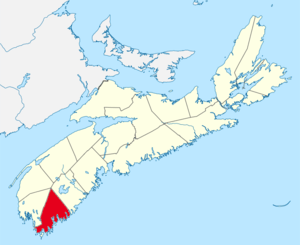Shelburne County, Nova Scotia
| Shelburne County | |
|---|---|
| County | |
 Location of Shelburne County, Nova Scotia | |
| Coordinates: 43°48′N 65°18′W / 43.8°N 65.3°WCoordinates: 43°48′N 65°18′W / 43.8°N 65.3°W | |
| Country |
|
| Province |
|
| Municipal district (s) | Barrington / Shelburne |
| Towns | Shelburne / Lockeport / Clarks Harbour |
| Established | 1784 |
| Electoral Districts Federal |
South Shore—St. Margaret's |
| Provincial | Shelburne |
| Area[1] | |
| • Total | 2,464.65 km2 (951.61 sq mi) |
| Population (2011)[1] | |
| • Total | 14,496 |
| • Density | 5.9/km2 (15/sq mi) |
| • Change 2006-11 |
|
| • Census Rankings - Municipal districts Barrington Shelburne - Towns Shelburne Clark's Harbour Lockeport |
7,331 (494 of 5,008) 4,828 (705 of 5,008) 1,879 (1,380 of 5,008) 860 (2,265 of 5,008) 646 (2,674 of 5,008) |
| Time zone | AST (UTC-4) |
| • Summer (DST) | ADT (UTC-3) |
| Area code(s) | 902 |
| Dwellings | 7651 |
| Median Income* | $40,514 CDN |
| |
Shelburne County is a county in the Canadian province of Nova Scotia.
History
Shelburne County was founded in 1784 shortly following the influx of Loyalist settlers evacuated from the newly independent United States of America. It was originally named Port Roseway, until it became a very busy town and was considered to be the capital of Nova Scotia, in which the name was changed to Shelburne in an attempt to please Lord Shelburne, the British Prime Minister from 1782 to 1783. The boundaries of Shelburne County were established by Governor and Council on December 16, 1785.
The first Loyalists arrived in May 1783. They were faced with a somewhat bleak environment in which to make their homes. The land is very rocky with acidic soil. There is also a lot of forest.
The area had previously been settled by French-speaking Catholic Acadians, many of whom had been deported to British Colonies. The new arrivals included Black Loyalists who were given substandard land, particularly around Birchtown. In 1796 about 600 Jamaican Maroons were deported to this area of Nova Scotia as well.
In 1824, at a time when the lines of a number of counties were being cut out and marked, the boundary between Queens and Shelburne Counties was surveyed.
In 1836 Shelburne County was divided into two separate and distinct counties with Yarmouth County being formed out of what had been part of Shelburne County.
In 1854, Shelburne County was divided into two districts - the District of Shelburne and the District of Barrington.
Demographics
|
Mother tongue language (2011)[4]
|
Ethnic Groups (2006)[5]
|
Communities
See List of communities in Shelburne County, Nova Scotia.
Towns
District municipalities
Access routes
Highways and numbered routes that run through the district, including external routes that start or finish at the district limits:[6]
|
|
|
Notable people
- James Bagnall
- John Alexander Barry
- John Brecken
- Mal Davis
- Jody Holden
- David George (Baptist)
- Nehemiah McGray
- Donald McKay
- Thomas Robertson
- Wishart McLea Robertson
- Nathaniel Whitworth White
See also
References
- 1 2 2006 Statistics Canada Community Profile: Shelburne County, Nova Scotia
- ↑ Censuses 1871-1941
- ↑ Statistics Canada: 1996, 2001, 2006 census
- ↑ Statistics Canada: 2011 census
- ↑ 2006 Statistics Canada Census Ethnocultural Portrait of Canada: Shelburne County, Nova Scotia
- ↑ Atlantic Canada Back Road Atlas ISBN 978-1-55368-618-7 Page 89
External links
- Photographs of historic monuments in Shelburne County
- Discover Shelburne County
- Shelburne County Today
- Western Counties Regional Library Website
- The Loyalist Link: The Forest and The Sea
 |
Digby County |  | ||
| Yarmouth County | |
Queens County | ||
| ||||
| | ||||
| Atlantic Ocean |